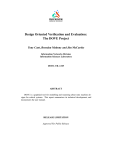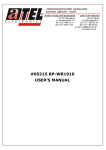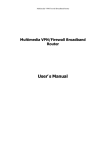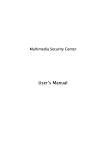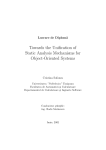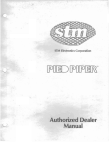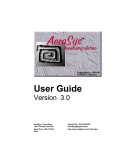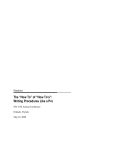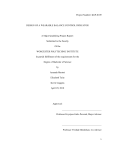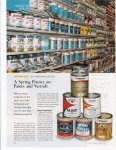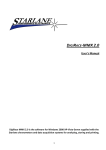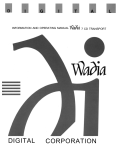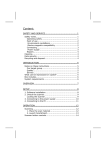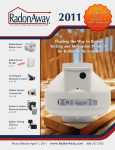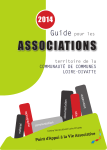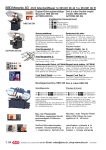Download DIGITAL STEREOPLOTTING USING THE PC
Transcript
DIGITAL STEREOPLOTTING USING THE PC-SVGA MONITOR J6zef Jachimski and Janusz Zielinski Facul ty of Mining Geodesy and Environmental Engineering University of Mining & Metallurgy (AGH) Cracow, Poland ABSTRACT: For the general purpose PC-SVGA computer a program package has been elaborated which enables the visualization and stereoscopic measurement of pairs of digital images. In the paper the most vital information concerning software and hardware design is discussed and the plotter characteristic is given. KEY WORDS: Computer Graphics, Analytical, Plotter, Stereoscopic, Digital Systems 1. INTRODUCTION land Information Systems (LIS) comprise variety of descriptive information, but on the first place they comprise geometrical data in a form of vectorial thematic maps. The number of thematic layers certifies not only the universality of a data base, but also the amount of money needed to keep the data base up to date. In the data base there is cadastral information, which is of legal type, and must be kept actual with the high geometrical accuracy. But in the data base can be several other t.hematic layers which comprise information about land use in t.he form of vectorial maps. Such information, however, often could be read easily directly from the aerial pictures. It would be less expensive to keep such geometrical information in the "passive" form of digital rast.er images scanned from aerial photographs, than to read in advance from them the coordinates of various contours, etc. for thematic geometrical vectorial information. Geometrisation of cont.ent of aerial photographs taken from the relatively low altitude, always must consider also the differentiation of the land topographical surface. The stereoscopjc images must be used to ensure proper perception and proper survey of details. There are two types of precisely measurable continuous tone images of the land surface: stereogram and stereoorthophotogram. A stereogram is a purely natural preduct of the photogrammetric flight and it would require only scanning t.o be stored in the digital data base of LIS. Stereoorthophotogram it is a preprocessed st.ereogram. It. consists of orthophotogram and its stereopartner [Blachut 1971, Jachimski 1978]. Both of t.hem they are preprocessed aerial photographs, therefore must be more expensive than natural stereopare, but t.hey offer great advantages. It is much easier to superimpose vectorial map on orthophotoplan than on a photograph, because neither elevations of points of numerical vectorial map nor orientation elements of photographs are needed. It is also easier to store and select proper fragment of orthophotogram and its stereopartner than to play with many framepictures in the perspective projection, which irregularly cover the land. Ortho-stereopares are produced in t.he process of differential rectification. Differential rectification can be carried out fully automatically using automatic correlation procedure, and t.his procedure doesn't. require any additional information but just properly oriented natural stereomedel. Automatic correlation is not advantageous however for preduction ortho-stereopares in large scales or medium scales for urbanized tel~ rains. For such cases it is safer to use a pre- processed digital elevation medel (DIM) to cont.rol also automatically the differential rectification process. Differential rectification of natural analogue pictures may be performed with a very high accuracy using a slit -differentialrectifier (eg.: Avioplan OR1-Wild, or Orthocomp Z2 Zeiss). The pre-scanned halftone analogue pictures in the raster-digital form can be also djfferentially rectified using adequate software package and even only PC- type computers. Here also rectification can be accomplished using automatic correlation rules [eg.Agnard et al 1990J or using preprocesed digital elevation medel [eg.Jachimski et al.1988]. Fig.1. Comput.er PC/386 with the colour 14" graphical monitor. The mirror stereoscope in special mount allows for the comfortable operator position when plotting (here the stereoscope is in the rest.ing position) Considering the real feasibility to include the digital halftone raster images to the LIS data base we started some programing experiments in 1982. First the program to preduce digital orthophoto was made [1985] than followed digital stereoorthophoto [1989] and programs to visualize and edit the vectorial numerical map on the PC monitor with the halftone digital raster image in the background. First we developed programs for EGA graphics, and than for SVGA 800x600. Finally programs for stereoscopic survey of photopairs on SVGA 800x600 was produced. It is our hope, that soon for better resolution SVGA 1024x768 programs will also be accomplished. All this programs are 127 densities for various image areas [Aguard et al .1990]. Considering the 30 steps halftone scale as sufficient for halftone image visualization, we can theoretically use 8 various coloL~s halftone scales simultaneously on the screen having additionally approach to 16 bright coloill~s to show varioL~ thematic vectorial maps (8x30+16=256). In practice however. for the human physiology reasons, the number of colours used simultaneOL~ly for half tone image visualization, or number of COlOllO L~ed for the vectorial map visualization must be limited to make the observation easy and to reduce the human operator confusion. It should be mentioned here, that there are Lmexpected difficulties in programming of graphics. The producers of the graphic cards openly supply usually only 1 imited routines l~ing the BIOS commands, which provide exclusively the functions for writing or reading the single pixel in the graphic card memory. This doesn't. facilitate the programming of t.he effective and fast graphic procedures such iiS procedure of a block visual ization needed for the image animation or the procedure of memorization of t.he chosen fragment of image on the screen, so to program before the G. Sutty' s [1990] pub 1 iCdti on was avai lable we had to disassembl y the BIOS procedures t.o grab the necessary inform,"ltion. The computer monitors of 19" or 17" size are often in l~e, but most popular and most economical is monitor 14" (image size is smaller, approx. 240x180mm). The monitor screen in the most cases is shaped like rectangle 4:3. From t.he point of view of proper image perception by the human operator it is quite important to form on the computer screen an image geometrically similar t.o the original. Let us assume that a scanner records t.he digital image using circular (or square) pixels arranged in the regular square grid. To reproduce such regulae digital image on the screen without. affine deformation a certain graphical mode should be employed, such, t.hat proportion of the number of pixels in the line to the number of lines on the screen should be 4:3=1.33, alike as proportion of the screen dimensions. The best shape of the image displayed on the screen is at. the graphical mode 1024x768 (1024/768=1,33) and 800x600 (1,33). The EGA 640x350 (1,9) mode gives great affine image deformation (43%). Even the high resolution 1280xl024 (1,25) used with the bigger monitors gives some, but rather small affine scale deformation (6%), which in many cases could be cleared by certain electronic adjust.ment of monitor though. From the point of view of image geometry the modes 1024x768 and 800x600 are excellent. On t.he 14" monitors in the first. case digital image is displayed using pixel ¢ = 0.23mm, in the second case pixel ¢ = O.30mm. Pixels of that size assures easy perception of a halftone image on the screen. The image granularity is noticeable, but doesn't make difficult neither the bare eyed observation nor the stereoscopic observation with the use of minAor stereoscope. For the stereoscopic observation the two stereoscopic images are displayed at once on the left and right halves of the screen. The stereoscope is placed horizontally in front of the monitor using special mount (fig.1 and 2), to allow for comfortable operator position. From the nature of the digital image appears that to each pixel the image coordinates are assigned almost in the moment of it.s registration (scanning). It is enough to apply a t.ransformation to standard pixel coordinates to get the coordinates of each pixel in the fiducial coordinate system. So, the to be applied as an user oriented peripherals to the LIS-. User should be able to examine his thematic vectorial map (eg. cadastral) on the PC monitor with the halftone terrain image in the background, and to produce a new vectorial thematic map if necessary using an accurate stereosurvey on the screen. 2. CONDITIONS OF THE METRICAL USE OF GRAPHICS ON PC-MONITORS The initial configl~ation of the PC-AT computer for which the Digital Screen Plotter was programmed included the ffiA graphics. B3A card allows to generate only 4 steps of luminosity for each of 3 RGB colours and for each of 640x350 points on the screen. To get a grey coloL~ of point one must generate equal It.uninosity for 3 RGB colours. To broaden the 4 steps grey-scale to show better the image details the 4 steps extension scale in the colour close to neutral grey (black green) was designed. Such 8 steps halftone scale was very contrast and gave urmaturally coloured but readable halftone images; unfortLmately it was not possible to broaden the scale further (for example to 12 steps). Remaining 8 of the 16 colours of B3A palette capacity could be used to visualize simultaneously variety of 8 different thematic layers of LIS vectorial numerical map; at that stage of development only 4 bright colours to show vectors (red, blue, green, yellow) were used in our program. The development of graphics hardware for PC computers resul ted in VGA and SVGA cards. TI1e available popular SVGA cards allow for the maximum resol ution of 1024..,,<768 pixels and palette of 256 colours available simultaneously on the screen of analcgue monitor. The luminosity of each of the basic RGB colours can vary3 within the range of 64 steps scale, what gives 64 =256 K of various colours available. The grey halftone scale can be produced within the maximum of 64 steps scale. For each colour (including grey) available simul taneously on the screen a palette code num-bel" of 0+255 is assigned, and one byte of memory on the graphic card is used to remember the code number for each pixel of the halftone image produced on the monitor screen. The maximum resolution requires 1024x768 x1Byte=768Kb memory available on the graphic card. There are relatively popular cards which offer 1~1b memory and can easily handle the 256 colours palette for the top resolution, but many of them offer only 512Kb memory, and therefore can produce only palette of 16 colours for the top resolution of 1024x768 (the code number for one pixel requires only half of a byte). In the case of 512Kb memory only lower resolution 800x600 pixels image can be produced with the use of 256 colours palette. Among the SVGA cards avai lable on the market quite interesting are cards employing graphic processor IT 3000 (or IT 4000) produced by TSENG LABORATORIES. The card producer supplies a card contro1ler program which enables the use of such functions of graphic processor as image magnification (ZOOM) or image shifting (SCROLL) in the chosen window on the screen. Admittedly the card contro1ler is open to fulfill such functions only in the standard lower graphics modes, but we found experimentally that they are available also in the high resolution modes (with some limitation however at the 800x600 pixel resolution). The broad 256 colours palette creates a chance to distinguish on the screen several thematic areas by the L~e not only the greyscale, but also the coloured scales of relative 128 used to remember one full screen when the resolution 800x600 is employed (800x600xlByte=469Kb). Similarly on the card with the memory lKb used at the 1024x768 resolution mode only 768Kb of memory is occupied by the image needed for one screen. So in the both cases a portion of memory reminds for writing in the card memory an image greater than needed for one screen visualization which enables the natural vertical image scrolling on the screen. An image projected onto the monitor screen is selected from the memory in the card by the address of the first pixel of that image (the upper left corner of the screen) within onedimensional image table (image vector) existing in the card memory. The natural image scrolling on the screen is obtained by successive selection of images shifted by the number of pixels which compose one full image line on the screen (image line length). Naturally certain line of a subsequently shifted image begins with the pixel number greater (smaller) by the number equal to the line length. The natural scrolling 1's limited to the number of additional picture lines (lines exceeding the screen capacity) existing in the card memory. Selection of the pixel address greater (smaller) than that really existing in the card memory causes the address overflow which is reduced by subtraction from that unusual address the number equal to the full capacity of the card memOJ:''Y. So e.g. the address next to the greatest existing on the card memory is the address of the first pixel in the image vector. Therefore the scrolling which exceeds the number of additional lines in the card memory gives in the cyclic visualization the repetition of that image portions which were removed from the screen at the beginning of scrolling. The effect of undisturbed cyclic scrolling in boundru}' conditions is possible only in case when the full card memory capacity can be divided by the image 1ine length without remainder. Otherwise the shifted image details within each subsequent 1ine of overflown numbers appear on the upper (lower) part of the screen. Luckily in such case exclusively the position of pixels selected by the overflown numbers is incorrect what causes practically the ruin of only the uppest or lowest margin of the image on the screen, leaving other parts of the image undisturbed. In the case of the resolution 102Lb~768 with the 1Mb memory in the card the undisturbed cycle of scrolling is assured (the lines with the overf1 Owrl numbers will create on the top margin of the screen the repetition of the lowest part of the image existing in the card memmy, or vice versa). But using the 800x600 resolution mode we are getting only 55 lines of undisturbed vertical scrolling (512xl024/800-600=55.36) , and afterwards the shift of image details by 288 pixels along subsequent lines appears on the upper or lower margin of the screen (0.36x800=288). Fortunately the remaining part of the screen remairs undisturbed. what makes the plotting possible even in such not very comfortable conditions. but using the popular (and not expensive) g:t-aphical mode hardware. The analysis of the value of y-parallax can show the cases when such less favorable conditions appear. Let us assume that an aerial stereopru-e was scanned using ¢=25,um pixels. This means, that on one monitor screen simultaneously can be displayed portion of the left and right picture of the size 400x600 pixels or 1024x768 pixels what after multiplication by pixel size gives the aerial picture area lOx15mm for 800x600 graphical mode or 12.8mmx19,2mm for the 1o24x768 graphical mode. Assuming that the usable photogram area does not exceed 220x220mm, we can calculate the y-parallaxes changeability at the cor- measurement of digital image displayed on the monitor lies in the selection of the No of the pixel assigned to certain detail of interest. The affinism of the image display on the screen does not influence the accuracy of measurement, but only disturbs the human operator imagination. It is one of the features of plotting on the screen, that there should not exist instrumental adjustment errors. Fig.2. Stereoscope in front of the monitor,equipment ready for the stereoplotting Similar rules of measurement are applied for the stcx'Gopare survey. There are Lwo stereopictures displayed on the two halves of the screen. On each of them the separate cursor of equal shape is superimposed. Both cursors can be moved simultaneously, and additionally the right cursor can be shifted only in the x-direction to measure the x-parallax. When measuring stereoorthophotogram such shifts of cursor are quite sufficient. But to prepare for survey on stereoorthophotogram when the components of the stereopare are badly correlated, or in case of preparing for survey of natural stereogram (survey for relative orientation), there is need for independent shift of the right cursor also in the ydirection. The stereoscopic measurement with the large y-observation-parallax is not possible. Therefore a certain software function have been designed which allows to clear such parallax by the renewed display of right and left images around cursors in similar position on the right and left portions of the screen. This function is designed to clear big y-parallaxes only during the preparatory stage of relative orientation. After the natural-stereopare has been relatively oriented the operator should be getting the y-parallax-free stereo-vision.To keep the cursor y-parallax-free during the observation of natural stereopare the vertical scrolling of at least one of the pictures composing stereopare must be used. And here certain problem of that scrolling range for the popular SVGA cards appears. On the card equipped with the memory of 512Kb (TSENG IT 3000) only 469Kb of memory are 129 torial contest, and blows-up all the image. As the result the vectors are not only longer. but also thicker, what is not very convenient. Therefore it is better to use specially pro<.;;rrammed procedures for image magnification. The advantage of the hardware ZOOM function it is its high speed though. The potential accuracy of the surveying on the screen is limited by the pixel original size (refen-ed to the original scanned picture, or to the object). Proper selection of pixels during the plotting procedure can not result in the accuracy greater than 50% of the pixel size. But there is a great possibility to enhance the measurement accuracy by the computer-supported measurement. If the measured point it is not a dot imaged by one pixel. but it is defined rather by the crossection of lines or by a target of the known shape - the mathematical analysis of chosen digital image portion can be applied. There are already excellent results published (eg. [Streilein & Beyer,1991] or (Jachimski & Trocha, 1992]). which show that in the very favorable conditions the point determination accuracy can be 0.1 or even 0.05 of the pixel size. This are very interesting prospects for the development of the plotting techniques on the screen of a monitor. ner of the photogram. For the 1024x768 mode the natural scrolling will not exceed 55 lines x 25~m = 1.375mm. Assuming that this would be the maximum of allowable y-parallax which will not cause the display irregularities, and assuming that values of elements of angular relative orientation are equal to each other. one can calculate that this angular elements should not exceed 1~8, what is not very little. When greater y-parallaxes increment will appear on the screen the plotting will still be possible, but with the above mentioned sensations, or with the intel~ediate rewriting of the card memory to conveniently display the adequate portions of both images). For the 1024x768 mode the natural scrolling allows for changes of y-pal-allaxes not greater than 256 lines x 25~m = 6.4mm within one screen image por-tion. This would be sufficient even for the very badly oriented aerial pictures. There are several possible shapes of cursors which could be used to point out the chosen pixel in the screen. We selected the most convenient: the alTOW with blinking pixel in its fore-part, the square thin frame with blinking pixel in the middle (seems to be the best for measurements), and the cross with the arm-lines broken in the middle and blinking pixel pointing out the center. The colour of cursor can be assigned freely, but the best colour of the bl inking whi te-dark pixel is similar to the colour of the halftone image exposed on the screen to be measured. The pixel blinking is controlled by the computer interrupt, so the blinking period does not depend on the programmed operation of editing the vectorial map. The techniqJe of operation using the chosen block of pixels is used to create and animate the cursor on the screen. The shapes of cursors are "remembered" in blocks (matrices) in the computer memory . The cursor matrix is written to the screen memory in the chosen cursor position, while the image position masked by the cursor is temporally kept in computer. To change the cursor position, the stored image portion must be rewritten to the present cursor position while the cursor wi 11 replace the neighboring portion of image (which is again stored in the computer), etc. One of the important features of the screenplotting it is simultaneous display of the vectorial map with the halftone image in the background. In the vector-graphics the objects defined as the line segments are visualized on the screen as a sets of pixels. The coexistence of the vectors superimposed on the halftone image on the screen is possible by the visualization of the raster halftone full image which is then masked by pixels which create a vector. The masked pixels must be erased for that from the screen memory, and they can be regenerated two ways: - by afresh visualization of the full screen containing vectors and halftone image, - by recording in the computer memory the pixels masked by line segments, to use them again if necessary. The first method have been used in our programs when the existing line segment had to be erased, while the second method was very convenient for the line segment animation (design). Zooming it is quite useful function of program when plotting on the screen. It can be used to enhance the operator confidence when selecting (pointing by cursor) pixels to measure the halftone image details, or to have a general look on the scene. The provided by the manufacturer ZOOM function (harware) is not always convenient. That hardware image magnification technique doesn't distinguish between the halftone and vec- 3. '!HE AGH DIGITAL SCREEN SI'EREDP~ As it was mentioned at the beginning of this paper, the program and hardware for the stereoplotting on the screen was developed by the authors at The University laboratories. Our Digital Screen Stereoplotter was originally designed as a stereocompiler [Blachut,1971] which can facilitate the use of the stereoorthophotographs by the LIS customers. It comprises the following functions: - the stereoscopic selection of the fragment of the ha 1 ftone image on the stereoorthophotogram displayed on the screen at the reduced scale, - selection of the thematic maps which are to be displayed on the monitor from the numerical map files. - the stereoscopic survey and plotting of chosen features from the stereoorthophotogram using polygon or trajectory in the selected colour. The colours are assigned to the max.6 thematic layers, - zooming the image displayed by the integer factor. The image in the original scale and enlargement can be replaced by each other on the screen, and plotting can continue in both scales, not desired details of the vectorial map can be erased from the screen, and then from the numerical map file (database), - the line segments can be animated on the screen to facilitate designing, - the inscriptions can be introduced. All the functions connected directly with point measurement or plotting of polygon or trajectory are mouse conb-olled. The mouse of PC/AT has 3 programmable buttons, which can be used to move cursor up or down in the space. to register the point, or beginning (end) of the line. In the preparatory mode the mouse can move cursors separately on the left or right picture of stereopare. When the left and right cursors points out identical details a command can be used to shift both cursors together with the images so, that both cursors are placed just in the center of the left and right screen parts. For the use of stereoorthophotographs which are in the local coordinate system the functions 130 Address for mail: were designed to use them with the data bank coordinate system. New coordinate system can be determined by transformation using two or more chosen points, or approximately by just one point, azimuth of given line segment and given scale factor (size of the pixel) . The present program was developed for the PC/AT, SVGA 800x600/256 card and 14" screen. Further development is planned for the card 1024x768/256 and not only for the stereoorthophotography but for the natural stereopares also. We hope for the liquid-crystal screen and for the optical discs which should facilitate very much the system versatility and comfort for the users. The combination of computer controlled liquid crystal glasses and the liquid crystal screen allows to get the stereo-effect without mirror stereoscope what makes the operator work much more comfortable. Considering the mass-use of the system though we must keep in mind also the possibilities of the popular and not expensive hardware. Prof. Dr. J6zef Jachimski & Mgr. Eng. Janusz Zi e 1inski Photogrammetric Research The Faculty of Mining Geodesy and Environmental Engineeri ng University of Mining & Metallurgy (AGH) Al.Mickiewicza 30-C4, 30059 Krak6w, Poland Tel. (04812)338100 ext.3826 or 2272, Fax (04812)331014 BIBLIOGRAPHY Agnard J.P. ,Gagnon P.A.,Nolette C.,Bouilianne M., 1990. itA computer based general photcgrammetric system". Photcgrammetric Engineering and Remote Sensing 5/1990 p.623-625 Blachut T. J ., 1971. "Mapping and Photointerpretation System Based on Stereo-orthophotos" . Mitteilungen aus dem Institut fur Geodesie und Photogrammetrie auch der Eidgen6ssischen Technischen Hochschule Zurich, 14/1971 Jachimski J., 1978. "Problem stereoskopii w ortofotografii" (The Stereoscopy Problem in Orthophotography) , Zeszyty Naukowe AGH Krak6w, Geodezja 54/1978,s.3-121 Jachimski J., Trocha W., 1992. "Dete1'1llination of the position of crosses with the subpixel accura cy on the image taken with the CCD camera" . Internat. Arch. Photogrammetry & Remote Sensing, Commission V, Washington 1992 Jachimski J., Mierzwa W., Pyka K. , Boron A., Zielinski J. ,1988. "Digital Image Rectification on Microcomputers for Orthophoto Production". Internat.Arch.Photogrammetry & Remote Sensing, Vol.27,part B9,p.II/135-II/144.Kyoto 1988. Streilein A., Beyer H.A., 1991. "Development of a Digital System for Architectural Photogrammetry". Proceedings of the XIV CIPA International Symposium, 2-5 Octber 1991, Delphi, Greece Sutty G., Blair St., 1988. "Advanced Programmer's Guide to the EGA/VGA.Brady Books,New York 1988 Sutty G., Blair St., 1990. "Advanced Programmer's Guide to the Super VGA. Brady Books, New York 1990 PillA II 480 Card, Enhanced Graphics Adapter, User Manual VGA-UL'IRA Users Manua I. PURETEK AUTOCAD version 2.17/ADE 3D, Reference Manual AUTOCAD wersja 10, P~cznik uZytkownika (The User Manual). Autodesk LTD, 1989 4. CONCLUSIONS The Digital Screen Stereoplotter developed at the AGH laboratories was designed as a tool for plotting of digital stereopares and pairs of continuous tone photogrammetric images in the digital form. At present system accepts stereoorthophotopairs and allows to plot simultaneously 6 different thematic layers of numerical map. The development continues and will provide for comfortable stereo-interpretation and surveying also natural stereopares in digital form. System, which uses only PC typical monitors and other peripherals can be considered as a program package for the mass-applications not only by professionalists but also by amateurs. The stereoplotting of digital images using the popular equipment could be introduced to the secondary school programs (geography lessons) to popularize the potentials of photogrammetry and remote sensing techniques among chi ldren. This way proper training could be provided and a very hard obstacle on the way to the mass-use of stereoscopic survey methods by the grown-ups could be removed. The authors hope that the digital screen stereoplotter type equipment will be used as a regular peripheral to the LIS-es, and stereoplotting will not be any more the exclusive skill of the very narrow group of operators. We are also of the opinion that for such mass-use by the nonphotogrammetrists the stereoorthophotographs provide so great advantages that the stereoortho rather than natural stereopares should be stored in the LIS files. The results gained during experiments with our Digital Screen Stereoplotter show that that type of plotting is very promising and experiments should be continued. 131





